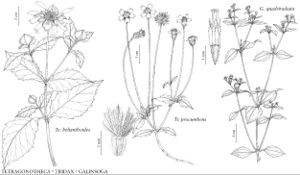Galinsoga
Fl. Peruv. Prodr., 110, plate 24. 1794.
| Taxon | Illustrator ⠉ | |
|---|---|---|
 | Tetragonotheca helianthoides Tridax procumbens Galinsoga quadriradiata | Yevonn Wilson-Ramsey Yevonn Wilson-Ramsey Yevonn Wilson-Ramsey |
Annuals, 2–62 cm. Stems erect. Leaves cauline; opposite; petiolate; blades (3-nerved) lanceolate to broadly ovate, margins entire or serrulate to serrate, faces glabrate to densely pilose. Heads radiate or discoid, in ± cymiform arrays. Involucres hemispheric to campanulate, 2.5–6 mm diam. Phyllaries persistent or falling, 6–9 [–16] in 2 [–3] series (elliptic, lanceovate, oblong, or ovate, outer shorter, herbaceous or scarious, margins entire or minutely laciniate). Receptacles conic, paleate (paleae persistent or falling, scarious, proximal broadly elliptic to obovate, often connate at bases or nearly to apices, united in groups of 2–3 to adjacent proximal phyllary, each complex often enclosing and shed with a ray cypsela; distal persistent or falling, lanceolate to obovate, entire or 2-lobed or 3-lobed, convex to conduplicate). Ray-florets [0–] (3–) 5 (–8) [–15], pistillate, fertile; corollas white or dull white to pinkish [purplish] (tubes pilose, laminae quadrate-obovate to oblong, lobes 0–3). Disc-florets 5–50 [–150], bisexual, fertile; corollas yellow, tubes (pilose) shorter than cylindric throats, lobes 5, deltate (anthers yellow; style-branch apices acute). Cypselae obconic to obpyramidal, glabrous or strigose (rays often shed with subtending phyllary plus 2–3 adjacent paleae); pappi 0, or persistent, of 5–20, white or gray, fimbriate, sometimes aristate scales. x = 8.
Distribution
North America, Mexico, West Indies, Bermuda, Central America, South America, in Europe, Asia, Africa, Atlantic Islands, Pacific Islands, Australia
Discussion
Species 15–33+ (2 in the flora).
Galinsoga is closely related to Sabazia Cassini of Mexico and South America and to at least some members of Alloispermum Willdenow, primarily from South America. Galinsoga might best be treated as a single larger genus including Alloispermum and Sabazia (J. M. Canne 1978; J. L. Panero et al. 1999).
Selected References
Lower Taxa
Key
| 1 | Phyllaries persistent; inner paleae 3-lobed, lobes 1/3+ total lengths, acute; disc pappi 0, or of 15–20 often gray, sometimes white, linear, fimbriate, obtuse scales 0.5–2 mm | Galinsoga parviflora |
| 1 | Phyllaries falling; inner paleae entire or 2- or 3-lobed, lobes to 1/3 total lengths, blunt; disc pappi 0, or of 1–5 or 14–20 white, lanceolate to oblanceolate, fimbriate, sometimes aristate, scales | Galinsoga quadriradiata |